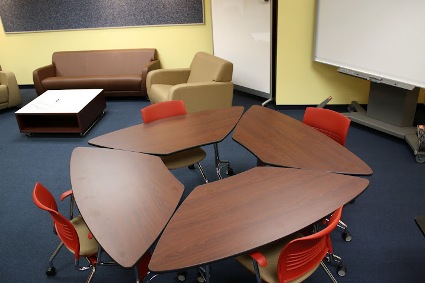Texas Wesleyan's Classroom.NEXT: 21st Century Learning In Action
- By Jennifer Demski
- 04/10/12

Texas Wesleyan's Classroom.NEXT |
When given the opportunity to renovate an existing classroom in the Eunice and James L. West Library into a 21st Century learning space, the team at Texas Wesleyan University’s Center for Teaching and Excellence created a competition called Classroom.NEXT, and called upon those who spend every day in classrooms around the campus – faculty and students - to submit designs for their ideal learning space. The winning design, the Radically Flexible Classroom, was announced in March of 2011, and on September 1st of that year, Classroom.NEXT was officially "open for instruction."
Elizabeth Alexander was a veteran history professor looking forward to retirement when she and five students in her Methods of Teaching History course submitted the winning design plans for the Radically Flexible Classroom to the CETL team. "I always thought I was a pretty good lecturer, but around the time that the competition was announced I had come to a realization that even my most successful students weren’t retaining a lot of the material I’d covered from one course to the next," explains Alexander. Alexander researched learning styles and was drawn toward inquiry-based history instruction, in which students work in groups to address and explore historical problems. Alexander and her Methods of Teaching History students drew inspiration for their design from the high school classrooms the students were observing in preparation for their student teaching assignments. "Using our observations and our research, we designed the ideal classroom to facilitate inquiry-based learning in history – the CETL didn’t provide a budget, so we didn’t hold anything back," explains Alexander.
The room features six four-piece tables with wheeled bases; the tables can be separated into individual desks or combined into a variety of configurations. All of the chairs are on wheels for easy mobility. Ten double-sided mobile whiteboards with wheeled bases reside in the room, along with a mobile Smart board. Tech-wise, the room features carts containing laptops and iPod Touches for each student, and six pico projectors.
"All of this flexibility allows me to really facilitate group work," remarks Alexander. "The whole classroom can be changed from a whole group discussion with the tables arranged in a circle to a more lecture-oriented discussion with the chairs all facing the front, to small group work with clusters of tables in about two or three minutes."
The room also features a lounge area featuring a sofa and two armchairs that surround a white-board table. In Alexander’s courses, the lounge area is reserved for the first complete group to arrive to class. "Student tardiness isn’t a problem at all now," laughs Alexander. "That lounge area has become a great tool for getting students to come to class on time, because nobody wants to disappoint their team."
Whitney Myers, an associate professor of English who teaches freshman writing workshops in the space, found that the lounge area is also unexpectedly beneficial to her students. "In my 8:00am class, a group of male students who’ve been with me for two semesters now have taken over the lounge space," explains Myers. "In the previous semester, when we were in a typical classroom, they rarely participated in class and they were very quiet. The same was true in Classroom.NEXT until about five weeks into the semester when they realized they could sit in the lounge area. Since then, their class participation has increased significantly, which is really interesting to me. There’s something about being physically comfortable that has allowed them to be more active in the class."
Both Alexander and Myers feel that the mobile whiteboards are a key component to the rooms’ success in facilitating 21st Century learning. "For the students, there’s something about writing their conclusions up on the mobile whiteboard that validates their work," explains Alexander. "They love having the ability to easily compare their conclusions with those of the other groups." Alexander has also found that the double-sided mobile whiteboards make great "cubicle walls." By walling off small groups of students with the mobile whiteboard, Alexander creates a collaborative small-group learning environment with more privacy, less distractions and less noise, while maintaining each group’s access to a whiteboard surface.
Myers takes advantage of the dual surfaces and easy mobility of the whiteboards in her instruction by, for example, having small groups of students list effective methods of persuasion on one side of their board and ineffective methods on the other. At the end of the exercise, the class lined the boards up in a row to see the commonalities and differences between each group’s lists. "It’s so easy to move these boards around," remarks Myers. "We’ve actually ordered a number of them for our traditional classrooms because they’re just fantastic."
As a writing professor, Myers already facilitated her classes in a style more akin to a collaborative workshop than a lecture, but the transitions between individual in-class assignments, peer critiques, and small group work were clunky and time consuming in the traditional classroom. "What this classroom has done is made the facilitation of that type of learning easier," explains Myers. "Even the small details, like the pico projectors, have streamlined the sharing of student work."
Alexander, though, spent the summer of 2011 redesigning the curriculum for the two courses she’d be teaching in the space in the fall, and continued to update the curriculum for her other courses throughout the school year to take advantage of the learning opportunities offered in this space. "Teaching this way is a lot more work," remarks Alexander, "but I think it’s incredibly worth it. My drop-out rate has gone down. The quality of my students’ written work and their ability to analyze sources and incorporate evidence into their papers has gone up. It’s making me a better teacher. In fact, it’s re-energized the way I feel about teaching. I’m at retirement age, and I’m not going to quit!"